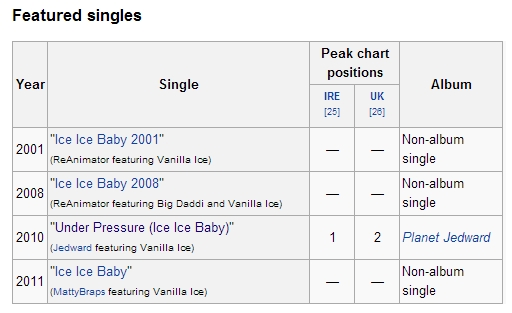There is a caste of has-beens that barely even seem to exist any more.
I periodically type “Vanilla Ice” into Google, and each time I feel like a prison screw looking inside a cell to make sure the prisoner inside hasn’t hanged himself with his trousers. Vanilla Ice doesn’t even have nostalgia value any more. He’s the worst thing: a novelty act who didn’t realise he was a novelty act. On his Myspace he still tries to sell it that he’s some huge star:

A number 1 record in the UK sounds pretty big. I went on to Wikipedia to assess the bigness.

So it wasn’t in the UK, it was in Ireland. Although I think some of Ireland is still part of the UK, so maybe that’s right. Sort of like how he could say “My song was a smash chart hit!” when the chart in question was Eritrea’s, or “My song is beloved by an entire nation!” when it merely enjoys frequent plays on the Vatican City gramophone.
Also, it wasn’t his song, it was someone else remaking his song.
Still also, the original song is more than twenty years old.
Also still also, the original song is based off a sample from yet another song.
While it’s sad to see this guy bluffing his pair of deuces like it’s a full house, I think he’s missing an opportunity. What The Fun? Listen, man, your original fans a), are now 30-40 years old, and b) don’t care about you. You don’t need to censor your language for teenyboppers on MTV any more.
He should become like fellow has-been superhero Tila Tequila and just write the most surreal mind-bending crap imaginable. That’s the lone benefit of talking to an empty room. You can say whatever you want.
 No Comments »
No Comments »
 If you enjoy Junji Ito as an ideas man and a visionary, Black Paradox will appeal to you. If your tastes lean more towards The Twilight Zone than The Human Centipede, you’ll enjoy Black Paradox. But you want a cohesive, effective story, Black Paradox comes up a little short.
If you enjoy Junji Ito as an ideas man and a visionary, Black Paradox will appeal to you. If your tastes lean more towards The Twilight Zone than The Human Centipede, you’ll enjoy Black Paradox. But you want a cohesive, effective story, Black Paradox comes up a little short.
After his recent forays into non-horror (Cat Diary, The Patriot Rasputin, even parts of New Voices in the Dark), it’s easy to suspect that Junji is getting bored drawing vampire bats and stitched-together corpses. That trend is continued by Black Paradox. Next to the lurching sickness of Gyo, the Mach 10 sci fi carnage of Hellstar Remina, and the gruesome Lovecraftian hellfuck of Uzumaki, Black Paradox dials the intensity way, way down.
Still, maybe that’s not bad. A new, less campy Junji Ito, relying on weirdness and surreality and psychological scares…sounds like we have a date! So what goes wrong?
Basically, Black Paradox showcases a chaotic, out-of-control, self-indulgent plot. Ito has a complete inability to develop any of his own ideas properly.
This manga is the story of four troubled people who have formed a suicide pact, and their adventures in and beyond this world. The first chapter is a horrific traffic collision of various random horror tropes (dopplegangers, evil robots, haunted mirrors…). It’s like Junji had ten ideas for a story and tried to write them all at once. If I was one of these people I’d kill myself just to make my life simpler.
Starting from chapter 2, things get a bit more coherent. One of the characters swallows some sleeping pills, is revived after a near-death experience, and grows a portal to another world in his lower stomach (or something). The other world is full of beautiful gemstones, and the other characters put their suicide plans on hold to harvest, sell and market the stones. But things soon get out of hand when it’s discovered that the stones are extremely dangerous, and the suicide group must go into hiding when they’re suspected of distributing terrorist weapons.
To enjoy Black Paradox’s story you basically can’t think at all about what you’re reading. There’s any number of things that just don’t make sense (that character who is chained to a bed for a month against her will…why? What did she do?) and sometimes Junji breaks his own rules (other characters start developing portals, even though they never swallowed sleeping pills).
I did think the characters were better than in most Junji Ito stories. Marisol is boring manga heroine #1428905 …but then we have the scheming, double-timing Doctor Suka and the morose, byronic Piitan.
There’s a really solid set of ideas powering Black Paradox, and the final chapter does earn its desired emotional response. I enjoyed the allegorical riffs on how willingly humans will screw themselves for short-term comforts. But the central thematic material is put to such bizarre, senseless use in Black Paradox. It’s like having strong, sturdy wooden boxes that you use to catalogue your booger collection.
Black Paradox also contains two bonus stories. “The Licking Woman” is a nice piece of mayhem, featuring demon-possessed tongues and plot holes, and “The Mystery Pavilion” is so short it doesn’t even have an opportunity to suck.
No Comments »
 When I first heard Master of Puppets I thought it the greatest metal album I’d ever heard. Eight years later and I think so still. This album has not yet been topped.
When I first heard Master of Puppets I thought it the greatest metal album I’d ever heard. Eight years later and I think so still. This album has not yet been topped.
The quality is fractal. How deep do you want to go? The songs are great. The riffs are great. The individual sound waves are great. There’s no filler, no stupid ideas, just an octet of songs that stand as templates on how to write heavy metal. From Pantera to Trivium to Five Finger Death Punch, everyone and their brother attempts to rip off this album. Nobody ever succeeds. If you want another Master of Puppets, you have no choice but to go to a record store and get a second copy.
The songwriting is dense and intricate, but catchy and memorable. After five listens you will remember Master of Puppets note for note. While it’s not as heavy as most thrash albums (even compared to Ride the Lightning, Metallica eases back on the trigger a bit), it features an unlikely savior: more clean sections. Five of the eight songs feature clean guitar (or unaccompanied bass) sections. While Metallica’s contemporaries mostly used clean guitar parts either as musical jokes (“Evil Never Dies” – Overkill) or as deceptive segments that sounded completely different to the rest of the song (“No Love” – Exodus), Metallica preferred to integrate them as cohesive parts of the song. James Hetfield realised that rather than participating in the “heavier heavier HEAVIER” arms race that leads invariably to self parody, heaviness can be obtained by another method: contrast. Light and shade. Loud and quiet. Punches, and periods to recover from the punches. Yes, it sounds obvious. No, very few bands get it right.
“Battery” and “Damage Inc” are quite fast, with Lars Ulrich making one hell of a racket behind the kit. “The Thing that Should Not Be” is a crushing homage to HP Lovecraft doesn’t move so much as…evolve. Section follows section like a fish sprouting legs. “Disposable Heroes” is long and harrowing. “Orion” is a very unboring progressive metal song with a set of amazing riffs.
Every song on Master is full of memorable ideas and exciting moments, but the title track towers above the rest. “Master of Puppets” is a completely amazing heavy metal classic that rivals “Iron Man” and “Kashmir”. Three classic hall-of-fame-worthy riffs in the intro alone. The song mostly listens like a merging of “Ride the Lightning” and “Creeping Death” but is far more elaborate, with an Iron Maiden-esque dual guitar section.
Flemming Rasmussen’s production is superb, trading in Ride’s muddy NWOBHM inspired sound for a pulverising metal attack so sharp and crisp that the tracks seem to arrive in your eardrums via vaccuum-sealed bags. The album finds all four members of their band at their peak as musicians, or close enough, an extremely tight and focused four-piece unit.
Ultimately though it’s the songs that make Master of Puppets (and Metallica) great. No matter how hard or often they fuck up, Metallica is still a great band thanks to this album. Remember Sir Edmund Percival Hillary? Does it matter that he could no longer climb Mt Everest at age eighty? No. You only need to do something great once. Metallica’s like that…no matter how many hipster art rock albums they release, they always have this in their back catalogue.
Still, though, guys…retirement. Think about it.
No Comments »





